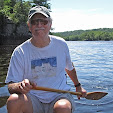HEIGHTS OF GRACE
From the moment we passed through the gates, it was clear our lives here would be intertwined with those of the local wildlife. Zebras roamed freely here and there, crossing the roads and grounds at will. Giraffes—lots of giraffes—grazed off the tops of 20-foot acacia trees.
Herds of waterbuck, a stocky member of the antelope family, wound their way along paths and between buildings, all over the property. And hippos...well, we were to meet them too, closer than we could ever have imagined.
It was here at Naivasha that I began to realize that, of all the amazing animals we were seeing in Kenya, giraffes would come to stand out (pun intended) as the ones that most surprised and delighted me. Of course, I'd seen giraffes before—perhaps a dozen in my life, at zoos—but never moving and feeding like this, freely and naturally.
Everything about them speaks of peace,
and I could listen all day.
I suppose it's their gentle power and the unhurried grace of their movement that touches me, especially considering their size (adult males reaching nearly a ton) and the apparent awkwardness of their shape. Everything about them speaks of peace, and I could listen all day.
(Our amiable safari-van mates, Maria and John, seemed to agree, coining a clever name for the place: Giraffic Park.)
WONDER ON THE WING
After check-in and lunch, we made our way down to the lake for a little cruise.
Lake Naivasha is the largest of the eight ecologically fragile lakes dotting Kenya's stretch of the Rift Valley. A freshwater body, Naivasha varies seasonally in depth, depending on rainfall amounts in the watershed. Right now, it's at a 20 year high, with thousands of acres of shoreline underwater, its graceful acacia trees stranded and slowly drowning.
High water or not, in terms of wildlife, Naivasha is known primarily for two things: birds and hippos. And, if you're a local, fish.
Winding our way in small motorboats along lush wetlands and through thin stands of wading trees, we could see that this is indeed prime habitat for birds—cormorant, ibis, egret, heron, stork…in fact, over 150 species of waterbirds alone.
 |
| Sacred ibis |
 |
| Black and white kingfisher |
 |
| Yellow-billed stork |
A highlight of the cruise was our guide's stopping to coax a spectacular African fish eagle to swoop down from a distant treetop to snatch a piece of fish bait he'd thrown out on the water.
 |
| African fish eagle |
PESKY KILLER HIPPOS
In utter counterpoint to the birds' easy flight lurked creatures we couldn't see—at least not right away—munching, right under our noses, on masses of abundant, bright green, succulent water plants. Our guide would stop the boat and ask us to watch a certain area, and eventually, a pair of round, pink ears would pop up. Then two huge, protruding eyes, followed by an enormous gray island of flesh. A quick breath, and down they'd go again.
They told us we'd have to have escorts
to get from dinner back to our cottages.
Hippos were bobbing up and down everywhere! Apparently aware that more folks die of confrontations with hippos than with any other wild animal in Africa, our guide gave them a wide berth.
That night, we were to hear that many of these same hippos exit the lake after dark to graze on land…on grass, in fact—the very grass surrounding the guest cabins at our resort. They told us we'd have to have escorts to get from dinner back to our cottages.
We suspected this might be a bit of showboating for the tourists—until, that is, we indeed had to zig-zag all over the grounds in the dark to find our way 'round all the huge, round, looming silhouettes in our path. (We could easily hear their munching and grinding as we passed!)
Clearly, given a choice between evasion and employing our escorts' rather silly weapons (flashlights and puny sticks), the former was the sensible option. (Once again, we felt the need to coin a slogan for the situation: Beware those pesky killer-hippos!)
(Next day, we're off to explore another of the Rift Valley lakes, Lake Nakuru, but that's another story. Stay tuned…)





No comments:
Post a Comment